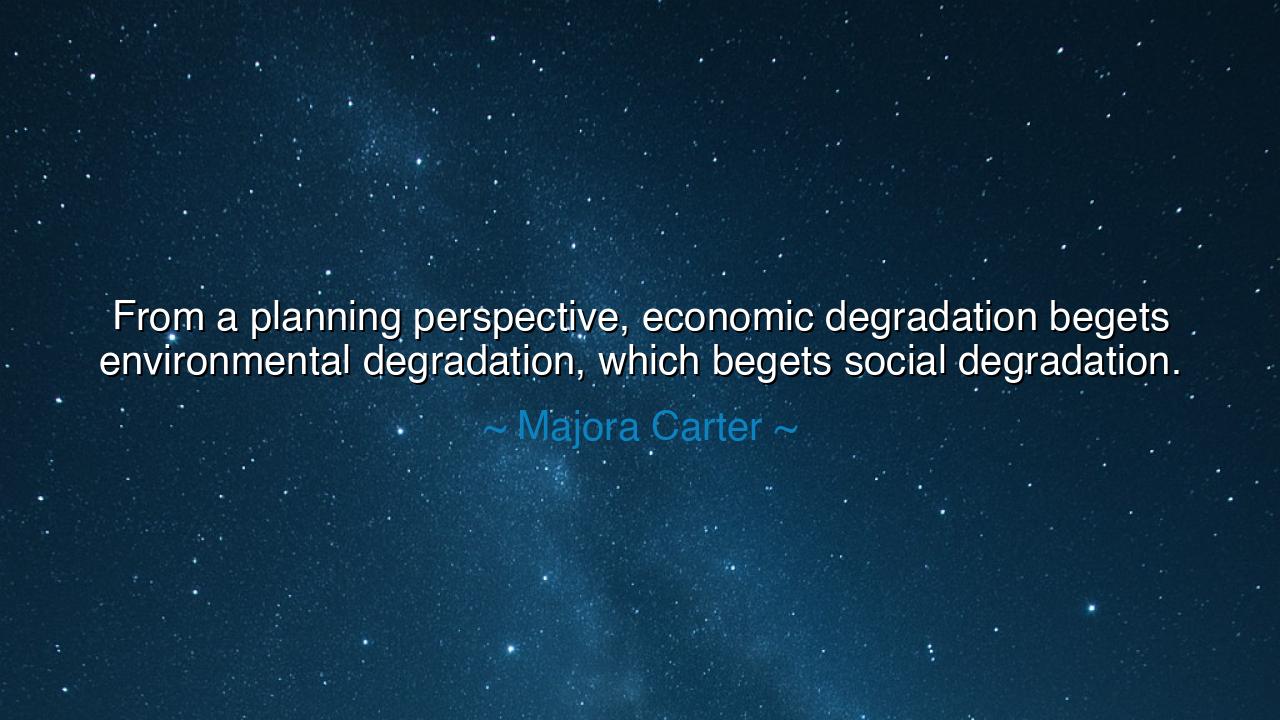
From a planning perspective, economic degradation begets
From a planning perspective, economic degradation begets environmental degradation, which begets social degradation.






In the councils of city-builders and hearth-keepers, a hard proverb is spoken softly: neglect breeds neglect. Majora Carter’s warning—“From a planning perspective, economic degradation begets environmental degradation, which begets social degradation.”—sets this ancient truth into civic terms. It is the chain of causation that turns bright neighborhoods dim: when work and wealth drain away, the earth underfoot is next to suffer; when the soil is wounded and the air is harsh, the bonds between neighbors fray. The lesson is stern but merciful, for what is made in sequence can be unmade in sequence: mend the purse, heal the place, and the people will rise.
Behold the first link: economic degradation. When honest labor leaves, roofs leak and shops shutter; tax coffers thin and potholes go unanswered. Empty lots multiply like unwatched fires. A city without opportunity becomes a storehouse of deferred repairs. In such famine, even well-meaning hands grow tired, and the cheapest choices—cheap fuel, cheap dumping, cheap design—masquerade as prudence. Thus the seed of ruin is sown not only in budgets but in habits.
From that soil springs the second link: environmental degradation. Where wealth retreats, smokestacks find welcome, transfer stations cluster, trees vanish to make way for choked roads, and the riverbank is treated as a back door. Dust gathers on windowsills; diesel speaks in coughs; summers swelter where shade once soothed. The land remembers every policy more faithfully than any archive. When planners make the earth a sacrifice zone, the earth answers with heat, flood, and ash.
And then comes the third link: social degradation. When children cannot find a clean breeze to play in, when elders fear both traffic and crime, when the nearest green is the color of a billboard, hope thins. Schools struggle; shops sell what numbs more than what nourishes; the stories neighbors tell about themselves grow smaller and harsher. No single act “causes” this sorrow; it is a braid of insults that finally frays the civic rope. Thus the chain completes itself: economy to environment to society, each wound feeding the next.
Yet there is a counter-story, and it bears Majora Carter’s own signature. In the South Bronx—long treated as a dumping ground—residents and organizers disputed the prophecy of decline. They argued that the neighborhood did not lack genius, only investment; not virtue, only respect. A waterfront once hidden by trucks was reimagined as a greenway; trees returned; paths invited feet and wheels; small enterprises budded around the new beauty. Air improved by inches; pride improved by miles. Here the chain ran in reverse: targeted economic renewal made environmental healing plausible, which in turn quickened social life—block parties where sirens once set the soundtrack, gardens where scrap once glared.
From this saying, take a clear law of planning: sequences must be honored. If economic degradation triggers the slide, then anchor the first interventions in dignified work—training tied to local projects, procurement that favors neighborhood firms, financing that stays when the ribbon is cut. If environmental degradation is the next wound, heal place as you hire people—plant trees with local crews, insulate homes with local apprentices, build parks that open to the street and open shifts on the payroll. Then tend the social weave—libraries lit late, clinics and counselors, festivals that stitch memory to hope—so the gains harden into culture.
Let counsel become action, as precise as a blueprint. Map burdens and blessings block by block; do not plan from averages. Tie every new dollar to triple return—economic (jobs and skills), environmental (cleaner air, cooler streets), and social (safe, shared spaces). Replace extractive uses with restorative ones: logistics depots become makers’ spaces; dead lots become gardens; storm drains become rain gardens; highways gain caps where schools and markets can breathe. Give neighbors a stake—community land trusts, co-ops, and local hiring—so that prosperity does not flee at the first scent of success. Do these things, and you will break the chain where it was forged, reversing the begetting: economic renewal begets environmental repair, which begets social flourishing—and a city once discounted will remember its worth.






AAdministratorAdministrator
Welcome, honored guests. Please leave a comment, we will respond soon